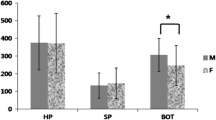Abstract
Background
The aim of this study was to integrate the physical findings of drug-induced sleep endoscopy with snoring sound analysis in patients with obstructive sleep apnea/hypopnea syndrome (OSAS) and to compare the findings with previously published data.
Methods
This was a prospective, non-randomized study. Participants were all candidates for surgical treatment of OSAS and formed three groups, retropalatal (RP) obstructions, retrolingual (RL) obstructions, and multilevel (ML) obstructions. At the time of DISE, recordings of concurrent snoring sounds were made. Mean pitch frequency, peak sound frequency, and fundamental frequency (Fo) components were determined.
Results
A total of 55 participants had mean age 46.2 ± 7.3 years, mean BMI 30.0 ± 3.7 kg/m2, and included 11 women (20%). Differences in mean pitch frequency, Fo, and peak sound frequency were all statistically significant between the RP and RL (p = 0.001), between ML and RL (p = 0.025) but were not significantly different between RP and ML. Mean pitch frequency of RP was lower than RL, and ML frequency was between RL and RP. The sound analysis graphics revealed RP waves with sharp peaks and lower frequencies and RL with smooth curves and higher frequencies. ML showed irregular patterns. Mean pitch frequency of RL was always above 400 Hz, whereas RP was below this value.
Conclusions
It is feasible to apply sound analysis to determine the site of obstruction during DISE. Combining the data may help surgeons make more accurate assessments of the pattern of the disease.

Similar content being viewed by others
References
Fujita S (1993) Obstructive sleep apnea syndrome: pathophysiology, upper airway evaluation and surgical treatment. Ear Nose Throat J 72:67–72 75-6
Friedman M, Tanyeri H, La Rosa M, Landsberg R, Vaidyanathan K, Pieri S, Caldarelli D (1999) Clinical predictors of obstructive sleep apnea. Laryngoscope. 109:1901–1907
Quinn SJ, Huang L, Ellis PD, Williams JE (1996) The differentiation of snoring mechanisms using sound analysis. Clin Otolaryngol 21:119–123
De Vito A, Carrasco Llatas M, Ravesloot MJ, Kotecha B, De Vries N, Hamans E, Maurer J, Bosi M, Blumen M, Heiser C, Herzog M, Montevecchi F, Corso RM, Braghiroli A, Gobbi R, Vroegop A, Vonk PE, Hohenhorst W, Piccin O, Sorrenti G, Vanderveken OM, Vicini C (2018) European position paper on drug-induced sleep endoscopy: 2017 update. Clin Otolaryngol 43(6):1541–1552
Kezirian EJ, Hohenhorst W, de Vries N (2011) Drug-induced sleep endoscopy: the VOTE classification. Eur Arch Otorhinolaryngol 268:1233–1236
Liistro G, Stanescu D, Verite C (1991) Pattern of simulated snoring is different through mouth and nose. J Appl Physiol (1985) 70:2736–2741
Fiz JA, Abad J, Jané R, Riera M, Mañanas MA, Caminal P, Rodenstein D, Morera J (1996) Acoustic analysis of snoring sound in patients with simple snoring and obstructive sleep apnoea. Eur Respir J 9:2365–2370
Shin H, Cho J (2014) Unconstrained snoring detection using a smartphone during ordinary sleep. Biomed Eng Online 116:1–14
Koo SK, Kwon SB, Kim YJ, Moon S, Kim YJ, Jung SH (2017) Acoustic analysis of snoring sounds recorded with a smartphone according to obstruction site in OSAS patients. Eur Arch Otorhinolaryngol 274:1735–1740
Levartovsky A, Dafna E, Zigel Y, Tarasiuk A (2016) Breathing and snoring sound characteristics during sleep in adults. J Clin Sleep Med 12:375–384
Akhter S, Abeyratne UR, Swarnkar V, Hukins C (2018) Snore sound analysis can detect the presence of obstructive sleep apnea specific to NREM or REM sleep. J Clin Sleep Med 14:991–1003
Peng H, Xu H, Xu Z, Huang W, Jia R, Yu H, Zhao Z, Wang J, Gao Z, Zhang Q, Huang W (2017) Acoustic analysis of snoring sounds originating from different sources determined by drug-induced sleep endoscopy. Acta Otolaryngol 274:1735–1740
Agrawal S, Stone P, McGuinness K, Morris J, Camilleri AE (2002) Sound frequency analysis and the site of snoring in natural and induced sleep. Clin Otolaryngol 27:162–166
Osborne JE, Osman EZ, Hill PD, Lee BV, Sparkes C (1999) A new acoustic method of differentiating palatal from non-palatal snoring. Clin Otolaryngol 24:130–133
Markandeya MN, Abeyratne UR (2019) Smart phone based snoring sound analysis to identify upper airway obstructions. Annu Int Conf IEEE Eng Med Biol Soc 2019:4233–4236
Li YR, Han DM, Ye JY, Zhang YH, Yin GP, Wang XY, Ding X (2006) Sites of obstruction in obstructive sleep apnea patients and their influencing factors: an overnight study. Zhonghua Er Bi Yan Hou Tou Jing Wai Ke Za Zhi 41:437–442
Author information
Authors and Affiliations
Corresponding author
Ethics declarations
Conflict of interest
The authors declare that they have no conflict of interest.
Ethical approval
All procedures performed in studies involving human participants were in accordance with the ethical standards of the institutional and/or national research committee and with the 1964 Helsinki declaration and its later amendments or comparable ethical standards.
This article does not contain any studies with animals performed by any of the authors.
Informed consent
Informed consent was obtained from all individual participants included in the study.
Authors of this study do not have a financial interest/arrangement or affiliation with one or more organizations that could be perceived as a real or apparent conflict of interest in the context of this subject of this study.
Additional information
Publisher’s note
Springer Nature remains neutral with regard to jurisdictional claims in published maps and institutional affiliations.
Rights and permissions
About this article
Cite this article
Gürpınar, B., Saltürk, Z., Kumral, T.L. et al. Analysis of snoring to determine the site of obstruction in obstructive sleep apnea syndrome. Sleep Breath 25, 1427–1432 (2021). https://doi.org/10.1007/s11325-020-02252-5
Received:
Revised:
Accepted:
Published:
Issue Date:
DOI: https://doi.org/10.1007/s11325-020-02252-5




